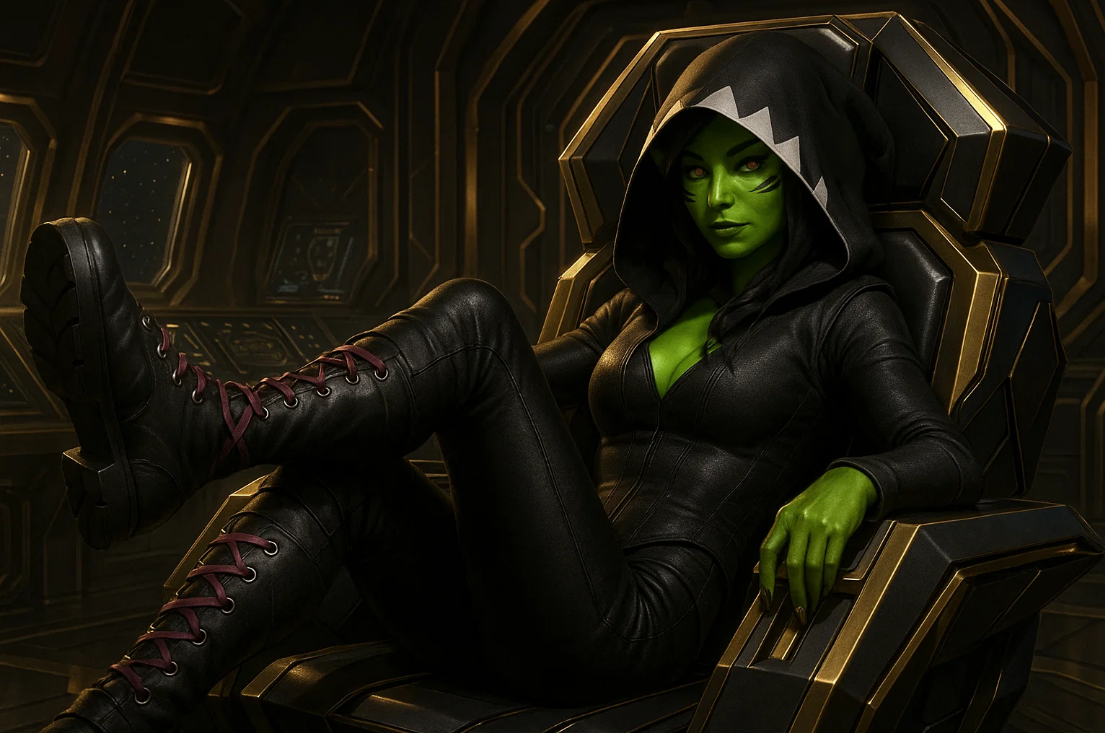M A N D A L O R E

LIMINALITY
"Between the living and the dead, between past and promise, the fire waits"
EOL SHA
Outer Rim Territories
The world of Eol Sha breathed fire.
Ash drifted like black snow across the open sky, carried on gusts that smelled of scorched stone and oil. Beneath that restless haze, the planet stretched in ribbons of volcanic glass and molten veins, its surface fractured and scarred from centuries of quiet decay. There were no cities here, no true settlements to speak of, only the outposts that clung to the ash plains like stubborn embers refusing to die. Yet even in ruin, Eol Sha drew the gaze of empires.
For beneath its crust slept Agrocite, a crystal once whispered about in war rooms and laboratories, now unearthed by miners who never understood the storm they were calling down. It shimmered faintly in the dark, a mineral with the temper of a god, capable of feeding machines, ships, and weapons that could change the course of history. To some, it was salvation. To others, it was a spark waiting to consume them all.
The Mandalorian Empire came first, their fleets descending through the upper atmosphere like silver blades through fog. Warships streaked across the horizon, their contrails glowing faintly against the ash. From orbit, the planet’s fury looked almost beautiful, like the forge of creation itself. For Mandalore, this was more than conquest. It was legacy. With agrocite in their grasp, the forges of the clans could awaken something greater than any superweapon, something that would ensure their people would never kneel again.
From the north came the Diarchy, its banners carried by legions that marched through the fire as if born of it. Their soldiers moved with precision, armored forms wreathed in the dust of old eruptions. To them, this was not ambition, but preservation. They had survived the void and the undead, carving civilization from the bones of ruin. They would not see it undone by another empire’s hunger.
Between them lay the scarred valleys of Eol Sha, where the drills had uncovered more than ore. Deep below the crust, past the magma-veined rock, an ancient chapel stirred. Its walls, carved from volcanic glass and wrapped in veins of luminous script, told stories of a people who once harnessed the Force itself to bind energy and life as one. The Paecians. A civilization long vanished, their ruins now whispering secrets that no living tongue should speak.
Those whispers spread fast. Prospectors and scavengers, cults and corporations, all came chasing the same promise: power. But the planet was no passive grave. It roared, and the ground itself seemed to shudder beneath the armies that came to claim it.
Now the first volleys flare across the horizon, crimson streaks of plasma carving through the veil of ash. The war drums of Mandalore echo from orbit, their rhythm pounding like thunder through the barren canyons. The Diarchy’s guns answer in kind, their lines advancing beneath banners that gleam against the dying light.
In that place between ruin and revelation, the war begins. And beneath the surface, the chapel waits.
Ash drifted like black snow across the open sky, carried on gusts that smelled of scorched stone and oil. Beneath that restless haze, the planet stretched in ribbons of volcanic glass and molten veins, its surface fractured and scarred from centuries of quiet decay. There were no cities here, no true settlements to speak of, only the outposts that clung to the ash plains like stubborn embers refusing to die. Yet even in ruin, Eol Sha drew the gaze of empires.
For beneath its crust slept Agrocite, a crystal once whispered about in war rooms and laboratories, now unearthed by miners who never understood the storm they were calling down. It shimmered faintly in the dark, a mineral with the temper of a god, capable of feeding machines, ships, and weapons that could change the course of history. To some, it was salvation. To others, it was a spark waiting to consume them all.
The Mandalorian Empire came first, their fleets descending through the upper atmosphere like silver blades through fog. Warships streaked across the horizon, their contrails glowing faintly against the ash. From orbit, the planet’s fury looked almost beautiful, like the forge of creation itself. For Mandalore, this was more than conquest. It was legacy. With agrocite in their grasp, the forges of the clans could awaken something greater than any superweapon, something that would ensure their people would never kneel again.
From the north came the Diarchy, its banners carried by legions that marched through the fire as if born of it. Their soldiers moved with precision, armored forms wreathed in the dust of old eruptions. To them, this was not ambition, but preservation. They had survived the void and the undead, carving civilization from the bones of ruin. They would not see it undone by another empire’s hunger.
Between them lay the scarred valleys of Eol Sha, where the drills had uncovered more than ore. Deep below the crust, past the magma-veined rock, an ancient chapel stirred. Its walls, carved from volcanic glass and wrapped in veins of luminous script, told stories of a people who once harnessed the Force itself to bind energy and life as one. The Paecians. A civilization long vanished, their ruins now whispering secrets that no living tongue should speak.
Those whispers spread fast. Prospectors and scavengers, cults and corporations, all came chasing the same promise: power. But the planet was no passive grave. It roared, and the ground itself seemed to shudder beneath the armies that came to claim it.
Now the first volleys flare across the horizon, crimson streaks of plasma carving through the veil of ash. The war drums of Mandalore echo from orbit, their rhythm pounding like thunder through the barren canyons. The Diarchy’s guns answer in kind, their lines advancing beneath banners that gleam against the dying light.
In that place between ruin and revelation, the war begins. And beneath the surface, the chapel waits.

URICORP REFINERY
Once the crown jewel of industrial ambition, the UriCorp Refinery now looms like a fortress against the ash-laden sky. Its towers rise from the molten plains in tiers of scorched metal and shattered glass, every wall etched with the strain of constant heat and time. The air hums with the low roar of machinery buried deep within its core, where drills churn through volcanic stone in search of the planet’s most volatile treasure.
Here, the Agrocite is mined, refined, and stored in sealed crucibles that glow faintly through the dark, a steady pulse of emerald light that beats like the heart of the world itself. The facility is massive enough to be seen from orbit, its landing pads crowded with derelict cargo haulers and gutted transports left behind by workers who fled the first wave of conflict. Every corridor, every refinery line, tells a story of desperation and discovery.
Control of the UriCorp Refinery means control of Eol Sha’s future. With its vaults and forges under command, one could feed the machines of war across the stars. To hold it is to hold dominion over the fires that shape empires.
Here, the Agrocite is mined, refined, and stored in sealed crucibles that glow faintly through the dark, a steady pulse of emerald light that beats like the heart of the world itself. The facility is massive enough to be seen from orbit, its landing pads crowded with derelict cargo haulers and gutted transports left behind by workers who fled the first wave of conflict. Every corridor, every refinery line, tells a story of desperation and discovery.
Control of the UriCorp Refinery means control of Eol Sha’s future. With its vaults and forges under command, one could feed the machines of war across the stars. To hold it is to hold dominion over the fires that shape empires.

PAECIAN CHAPEL
Hidden beneath the blackened crust of Eol Sha lies the Paecian Chapel, a cathedral carved into the bones of the planet itself. Its discovery began with the echo of drills striking something that should not have been there, smooth stone instead of molten ore, marked with glyphs that glimmered in the dark. When the miners broke through, they uncovered halls that seemed untouched by time, their walls alive with faint patterns of light that pulsed to some silent rhythm.
The architecture is impossible by modern standards. The pillars twist in geometric spirals, each one threaded with veins of luminous crystal. Murals stretch across the vaulted ceilings, depicting figures in communion with stars, their hands raised to command both life and death. At its center rests an altar of obsidian glass, cold and flawless, surrounded by the remnants of machines whose purpose defies reason.
To the scholars and mystics who have glimpsed its depths, the chapel is more than ruin. It is revelation. The Paecians were said to have bridged the gap between spirit and substance, binding the Force into the very matter of creation. To study their secrets might reshape the understanding of existence itself, or awaken something that should have remained buried beneath the fire.
The architecture is impossible by modern standards. The pillars twist in geometric spirals, each one threaded with veins of luminous crystal. Murals stretch across the vaulted ceilings, depicting figures in communion with stars, their hands raised to command both life and death. At its center rests an altar of obsidian glass, cold and flawless, surrounded by the remnants of machines whose purpose defies reason.
To the scholars and mystics who have glimpsed its depths, the chapel is more than ruin. It is revelation. The Paecians were said to have bridged the gap between spirit and substance, binding the Force into the very matter of creation. To study their secrets might reshape the understanding of existence itself, or awaken something that should have remained buried beneath the fire.







































































